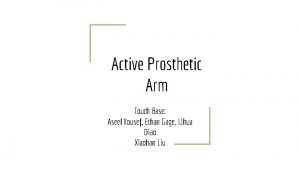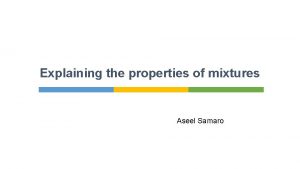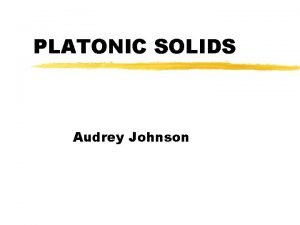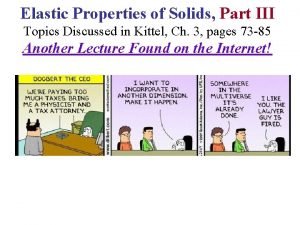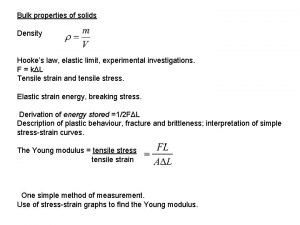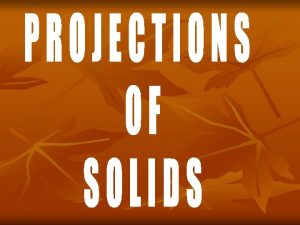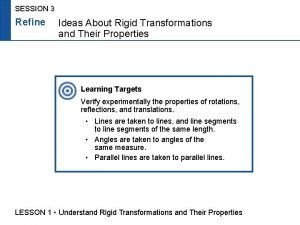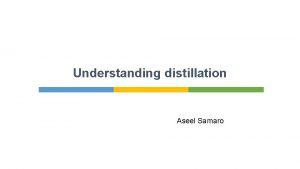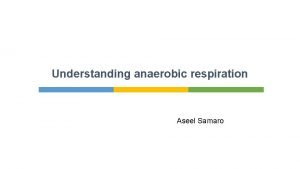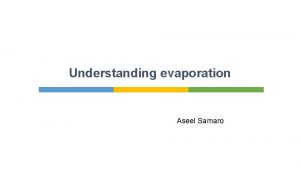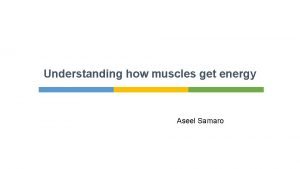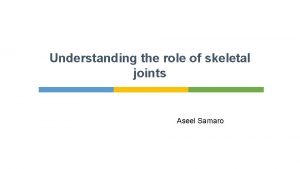Understanding solids Aseel Samaro Introduction Some properties are
























- Slides: 24

Understanding solids Aseel Samaro



Introduction § Some properties are common to all solids and help to define them. § Differences between solids can be explained using the particle model.

General properties of solids § Except for mercury, all metals are solid at room temperature. üThey have high melting point üHigh boiling point üThey all conduct heat and electricity well. § A few non-metallic solids share these properties, but many others have very different properties.

§ Melting point: is the temperature at which it changes state from solid to liquid § Boiling point: the temperature at which a liquid boils and turns to vapour.

Flow: üSome solids appear as if they can flow, like sand. üSeen under a microscope, such a solid is made up of many individual grains. üThey flow over each other.

Changing shape: üSome solids are malleable – they can be hammered into shape without being broken. üSolids such as plastic are brittle – they will snap if hit. üMetals are ductile – the layers of atoms are able to slide past each other, so they can be pulled into extremely thin wires.

§ Malleable: ability to be hammered or pressed into shape without breaking or cracking.

§ Brittle: hard but liable to break easily. § Ductile: the ability to be drawn out into a thin wire.

Strength: üis the ability of a solid to withstand a force. üMetals are generally very strong, but waxy solids are easily squashed.

Hardness: ü is a measure of how easy it is to scratch a solid – it is not the same as strength. üSlate and concrete are very strong solids, but are easily scratched so they are not as hard.

Solubility üSome solids, salt for example, dissolve readily in water – they are soluble. üOthers, such as sand, do not dissolve and some, such as sodium, react chemically with water.

Conduction of heat and electricity üMetals will readily conduct heat and electricity, whereas non-metal solids, like plastic and rubber, will not. üThe only exception is graphite, which conducts electricity even faster than metals.

Substance Hardness aluminium 3 carbon (diamond) 10 iron 4 silver 2. 5 tin 1. 5 copper 3

Which property is responsible for making copper wires? Use the data in the previous table to explain which material you would use on the end of drill.

What are alloys? § Alloys, such as brass, bronze and chrome, are mixtures of metals. § They are often stronger than the individual metals they are made from. § Different shapes and colours can be used to represent the different types of atoms in the particle model.


Duralumin is an alloy made from 96 per cent aluminium (very light) and 4 per cent copper (heavy). What might the particle model look like? Use the particle model to explain why some alloys are less ductile than the metals they are made from. The arrangement of the particles in an alloy does not allow for smooth layers; this makes it much harder to pull the metal into thin wires.

Explaining properties § Strength, shape and hardness all depend on the strength of the intermolecular forces between the particles in a solid. § Solubility also depends on intermolecular forces. § In solids which dissolve, forces between the particles of the solid are weaker than the forces between the particles of the solid and the particles of the liquid. § In insoluble solids, the forces between the particles of the solid are too strong to be overcome. § The arrangement of particles in metals is special, accounting for their ability to conduct heat and electricity.

Metals can conduct heat and electricity because they have negative particles that move freely.

How would you modify the particle model to show a solid with strong intermolecular forces and one with weak intermolecular forces? Explain as many differences in the properties of copper and wax as you can using appropriate particle models. Copper is very hard and strong wax can break easily and is soft The particle model should show that copper has much stronger intermolecular forces than wax copper is ductile.

Did you know…? § Diamond has the strongest intermolecular forces of all solids. § This makes it the strongest, hardest material in the world. § Drills that cut through rock are tipped with diamonds.

Thank you
 Antigentest åre
Antigentest åre How to identify pure aseel
How to identify pure aseel Aseel yousef
Aseel yousef Lab samaro
Lab samaro What is stomata
What is stomata Lab samaro
Lab samaro Samaro property
Samaro property Solids liquids and gases section 2 properties of fluids
Solids liquids and gases section 2 properties of fluids Properties of solids and liquids
Properties of solids and liquids Platonic solids
Platonic solids Properties of solid liquid and gas
Properties of solid liquid and gas 12 properties of matter
12 properties of matter Covalent molecular and covalent network
Covalent molecular and covalent network Elastic properties of solids
Elastic properties of solids Lattice vibrations and thermal properties of solids
Lattice vibrations and thermal properties of solids Weight=density*volume
Weight=density*volume Liquid information
Liquid information Bulk properties of solids
Bulk properties of solids Cone projection of solids
Cone projection of solids Understanding rigid transformations and their properties
Understanding rigid transformations and their properties Sometimes you win some sometimes you lose some
Sometimes you win some sometimes you lose some Sometimes you win some sometimes you lose some
Sometimes you win some sometimes you lose some Ice cream è countable or uncountable
Ice cream è countable or uncountable Contact and non contact forces
Contact and non contact forces Some say the world will end in fire some say in ice
Some say the world will end in fire some say in ice


